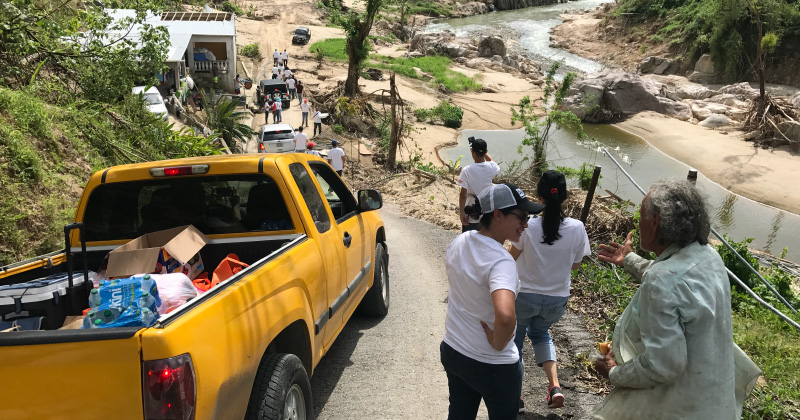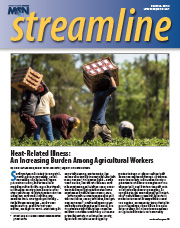
Puerto Rico is subject to natural events that could result in disasters, such as hurricanes, earthquakes, droughts, heavy rains, and heat waves, among others. Due to the climate crisis caused by carbon emissions and other human behaviors, the projections of the occurrence of natural events related to the climate, such as hurricanes, show that they will be more intense in the coming years. Puerto Rico has faced consecutive weather-related natural disasters for the past five years, among them two droughts and two hurricanes, including Hurricane Maria in 2017. The island is in an area of high seismicity, which gives way to telluric events such as those experienced in the southern half of the island during late 2019 and early 2020. In addition, there have been other public health emergencies such as the COVID-19 pandemic, causing disruption in essential services for individuals. Although the impact of these events has been quantified in economic terms and physical damage such as the loss of infrastructure and basic resources, it is important to also determine the effect that these events have on health.
Climate and Health Events
Hurricane Maria killed about 2,645 people in Puerto Rico. Most of these people reportedly died for lack of medical care or resources to address their health conditions. The impact on those households who suffered from chronic diseases was considerably greater than on healthy populations. Dr. José Rodríguez, Senior Medical Advisor for Migrant Clinicians Network in Puerto Rico, witnessed this firsthand, including among patients with respiratory diseases who did not have access to electricity and therefore could not carry out their therapies, or who did not have access to oxygen tank replacements.1 Researchers found that the majority of excess deaths due to Hurricane Maria were related to chronic disease, including diabetes and heart disease.2,3
Dr. Rodríguez, who also serves as Medical Director of Hospital General Castañer in Lares, Puerto Rico, has highlighted on several occasions the importance of preparing patients with chronic diseases for an event of this magnitude. Within the population diagnosed with these conditions, older adults stand out since, according to the Centers for Disease Control and Prevention (CDC) and presented by the National Institute on Aging, 85% of older adults have at least one chronic health condition and 60% have at least two chronic diseases.4 Maintaining good health is particularly challenging when living conditions are altered and resources are not available. Therefore, the CDC considers this population vulnerable when it comes to natural disasters and/or intense weather events.
Sometimes it can be easy to identify those diseases that can be complicated by a weather event or natural disaster. At other times, the impact may not be so obvious. That is, there are direct impacts and indirect impacts that can alter or destabilize a health condition. An example of a direct impact is a complication of asthma because of the deterioration of the ambient air quality during a wildfire. An indirect impact is not having access to respiratory therapy due to the lack of electricity. Therefore, in addition to paying attention to the numerous environmental events that may have health impacts and warrant caution from health providers and their patients, it is extremely important to focus preparation efforts on how patients will keep their health stable and attend to their conditions during an emergency. This includes determining to which hospital they will go in case of destabilization. It should be noted that patients must consider the closest health care institution to which they have safe road access, as well as consider those institutions close to the places where they could take refuge or relocate during an emergency.
Health Care Before, During, and After a Disaster?
On an individual basis, emergency management agencies recommend that all households have resources for at least 10 days after an emergency. All residents should be prepared, but preparation does not look the same for everyone. Older adult populations that experience chronic health conditions such as diabetes, hypertension, asthma, kidney conditions, and cancer, among others, must be prepared to attend to their condition independently until the external situation stabilizes and community facilities get back to normal. Considering our recent experience with Hurricane Maria, it is important to make efforts to prepare properly. Similarly, many individuals have additional vulnerabilities such as homes in floodplains or that are not earthquake resistant, leading individuals to be more likely displaced. It is important to identify tools that promote and provide for the continuity of care for this population.
Community-wide strategies are as important as individual and family emergency plans. In Puerto Rico, several communities have taken the initiative to prepare in case another emergency occurs. These communities created strategic emergency preparedness teams whose purpose was to establish a community emergency plan. The effort is part of a project funded by the Bristol-Myers Squibb Foundation and led by Migrant Clinicians Network and its office in Puerto Rico. Community mobilization helps individuals to recognize local resources that were otherwise ignored or not identified in the support infrastructure while updating the emergency plans of the community and its health centers to include them. This process also enables communities to acquire new skills in emergency management and resources to address behavioral health during these events. During the development of community emergency plans, it is advisable to pay special attention to the preparation of community members who have a chronic disease, so that the community can learn how to support this population during periods of crisis. Part of the process of protecting community health includes identifying and building partnerships to help manage emergencies. After encouraging the establishment of a family emergency plan, it is recommended that communities discuss with their members what other things can help them get through these events without regrettable situations. During these discussions, communities can identify special needs within their members, like older adults who require assistance in preparing their roof for an upcoming storm by cleaning downspouts and rain gutters to avoid flooding that may affect nearby homes. It may also identify members of the community who might be able to support other neighbors with their skills, like providing first aid or lending and operating machinery to remove a fallen tree. A community preparedness plan will likely include neighbors who will take responsibility for those actions. Finally, this information when shared with the health center can provide a quicker and more informed response from providers in case a disaster occurs.
Just as communities have tools and strategies for emergency management, there are tools and initiatives that can be implemented in health centers to serve vulnerable populations, such as patients with chronic diseases, during these events. Last month, MCN began its third year of the community mobilization project for emergency management with the participation of four new health centers and communities in Puerto Rico. This year, together with the Patillas Primary Health Services Center, MCN is integrating its Health Network tool with the purpose of providing continuity of care to people who may be displaced within or outside of Puerto Rico due to a disaster or emergency. Health Network is MCN’s virtual case management system, wherein patients with ongoing health concerns are assisted by MCN to find care at their next location, have medical records transferred, and receive assistance in applying for services and programs for which they are eligible including sliding scale fees. This health center will perform a risk and vulnerability assessment of the community to identify those patients who are most likely to be displaced or whose health care may be interrupted due to emergencies. Those patients will be pre-enrolled in Health Network. In the case of an emergency displacement or lack of services in their areas due to disaster, a Health Network Associate will follow up to ensure they can maintain their health during and following the disaster. The objective of this pilot program is to prevent patients with chronic diseases such as cancer, diabetes, asthma, and hypertension from interrupting their care that cause substantial complications to their health and even death.
Learn about MCN's Climate Justice work here: Climate Justice | Migrant Clinicians Network
References:
1 Seda CH. “Response from the Field: Dr. Jose Rodriguez on Hurricane Deaths in Puerto Rico.” Clinician-to-Clinician: Migrant Clinicians Network Blog. 31 May 2018. https://www.migrantclinician.org/blog/2018/may/response-field-dr.-jose-rodriguez-hurricane-deaths-puerto-rico.html. Accessed 8 June 2021.
2 Ascertainment of the Estimated Excess Mortality from Hurricane Maria in Puerto Rico. Milken Institute School of Public Health, George Washington University. https://publichealth.gwu.edu/sites/default/files/downloads/projects/PRstudy/Acertainment%20of%20the%20Estimated%20Excess%20Mortality%20from%20Hurricane%20Maria%20in%20Puerto%20Rico.pdf. Accessed 2 June 2021.
3 Cruz-Cano R, Mead EL. Causes of Excess Deaths in Puerto Rico After Hurricane Maria: A Time-Series Estimation. Am J Public Health. 2019;109(7):1050-1052. doi:10.2105/AJPH.2019.305015
4 “Supporting Older Patients with Chronic Conditions.” National Institute on Aging. U.S. Department of Health & Human Services, National Institute of Health. https://www.nia.nih.gov/health/supporting-older-patients-chronic-conditions. Accessed 2 June 2021.

Read this article in the Summer 2021 issue of Streamline here!
Sign up for our eNewsletter to receive bimonthly news from MCN, including announcements of the next Streamline.